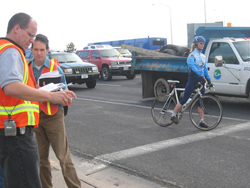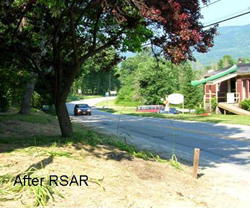RSA Benefits
A number of reports suggest that the RSA process is cost-effective, although most reference qualitative rather than quantitative benefits. Establishing and meeting a target benefit/cost ratio for RSAs is not the motivating factor behind support for RSAs at PennDOT, KDOT or Iowa DOT. These agencies suggest that the benefits of RSAs are substantial, but largely immeasurable. Nonetheless, the major quantifiable benefits of RSAs can be identified in the following areas:
- Throwaway costs and reconstruction costs to correct safety deficiencies identified once roads are in-service are either avoided or substantially reduced.
- Lifecycle costs are reduced since safer designs often carry lower maintenance costs (e.g., flattened slope versus guardrail).
- Societal costs of collisions are reduced by safer roads and fewer, less-severe crashes.
- Liability claims, a component of both agency and societal costs, are reduced.
The benefits of RSAs are that they:
- May help produce designs that reduce the number and severity of crashes
- May reduce costs by identifying safety issues and correcting them before projects are built
- Promote awareness of safe design practices
- Integrate multimodal safety concerns
- Consider human factors in all facets of design

Road Safety Audit Team reviewing project plans
(Click For Larger Photo)

Road safety audit team reviewing plans on
site at a coastal highway (Click For Larger Photo)
Benefits Reports
- Road Safety Audits: An Evaluation of RSA Programs and Projects
- AAA Michigan Road Improvement Demonstration Program Evaluation [PDF 1.02 MB]
- Evaluation Studies for the AAA Road Improvement Demonstration Program [PDF 2.77 MB]
PennDOT's RSA Experience
"Pennsylvania DOT has done 40 RSAs. We've found that RSAs are a valuable, low-cost tool that enhances the safety of a project by providing unbiased early recommendations for the project based on safety and multimodal needs. We intend to make RSAs an easily and frequently used tool in the design process."
Girish (Gary) N. Modi, P.E.
Chief, Safety Management Division
Bureau of Highway Safety and Transportation Engineering
Pennsylvania DOT
Link to PennDOTs experiences to learn the many ways RSAs have been beneficial to them.
Iowa DOT's RSA Experience
"Iowa DOT has implemented road safety audits on proposed resurfacing projects. Previously, very few safety improvements were incorporated into our resurfacing projects. We now see that our staff consistently look for and implement numerous low-cost safety improvements on Iowa's roads."
Thomas M. Welch, P.E.
State Transportation Safety Engineer (Retired)
Iowa DOT"States must now annually report 5% of their most severe safety locales, and how they intend to remedy those problems. RSAs offer a credible response to such challenges."
Thomas M. Welch, P.E.
State Transportation Safety Engineer (Retired)
Iowa DOT
Maryland DOT's RSA Experience
"Maryland State Highway Administration believes RSAs are an invaluable tool in building and maintaining a safer highway system. RSAs are the right thing to do. Maryland SHA has a policy of conducting RSAs on our roadways. Courts are reluctant to second guess the policy decisions made by a State DOT when those decisions are based on a thorough engineering review."
Norie Calvert
Chief-Design Technical Services
Maryland Department of Transportation
State Highway Administration

Road safety audit team observes various modes of transportation at an intersection
(Click For Larger Photo)
NYDOT's RSA Experience
NYDOT has also benefited from conducting their own RSAs. They have experienced the following:
-
Crash reductions occurred at over 300 high crash locations treated with low cost improvements.
-
Crash reductions ranged from 20% to 40%, depending on the type of improvement implemented.
South Carolina DOT's RSA Experience
The South Carolina DOT RSA program has had a positive impact on safety. Early results from four separate RSAs, following 1-year of results, are promising. One site, implementing 4 of the 8 suggested improvements saw total crashes decrease 12.5 percent, resulting in an economic savings of $40,000. A second site had a 15.8 percent increase in crashes after only 2 of the 13 suggestions for improvements were incorporated A third site, implementing all 9 suggested improvements saw a reduction of 60% in fatalities, resulting in an economic savings of $3.66 million dollars. Finally, a fourth location, implementing 25 of the 37 suggested safety improvements, had a 23.4 percent reduction in crashes, resulting in an economic savings of $147,000.
International RSA Experiences
A recent AUSTROADS study assessed nine design stage RSAs. Below is a summary of the findings of the study:
-
The benefit/cost ratios realized when recommendations of the RSAs were implemented ranged from 3:1 to 242:1.
-
Approximately 75% of all implemented recommendations had benefit/cost ratios greater than 10.
-
The majority of design audit findings required only very low-cost responses (65% of recommendations had a cost < $1,000).
This study also evaluated the recommendations from RSAs done on existing roads. Below are the findings:

Road Safety Audit Team watching traffic signal operations and road users at an intersection
(Click For Larger Photo)
-
Benefit/cost ratios ranged between 2.4:1 to 84:1.
-
Over 78% of all recommendations had benefit/cost ratios > 1.0
-
Approximately 47% of all proposed actions had benefit/cost ratios > 5.0
-
Approximately 95% of all recommendations with a cost less than $1,000 had benefit/cost ratios > 1.0.
In addition, other international communities have experienced their own benefits of conducting road safety audits:
-
1% to 3% reduction injury costs
-
Minimizes crashes
-
Minimizes need for remedial work
-
Reduces project's life cycle costs
-
Improves the awareness of safe design practices
-
Leads to improved standards and management practices
-
Considers the safety needs of all road users
-
Cross-fertilization between departments in an agency
These benefits were cited from various international publications and based on experiences and observations of auditors and agencies that have implemented road safety audits. The cost reduction figures are based on the findings of studies in Great Britain.
Before

View of roadway, shoulder and overgrown vegetation
(Click For Larger Photo)
After

View of shoulder and improved sight distance after vegetation was removed.
(Click For Larger Photo)
